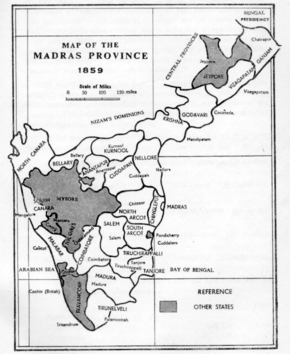Travancore rebellion facts for kids
The Travancore rebellion was a fight against the British East India Company. It happened in 1808 and 1809. The leaders were the prime ministers of the Indian states of Travancore and Cochin. They also had help from the Sikhs who ruled Punjab.
Quick facts for kids Travancore rebellion |
|||||||
|---|---|---|---|---|---|---|---|
|
|||||||
| Belligerents | |||||||
|
|
|||||||
| Strength | |||||||
|
|
||||||
| Casualties and losses | |||||||
|
|
||||||
Contents
Why the Rebellion Started
In 1795, Travancore and the British East India Company made a deal. This deal was called the Subsidiary Alliance Treaty. It meant the Company would keep an army near Travancore to protect it. In return, Travancore would pay for the army's upkeep.
The Company helped Travancore in 1789 during an invasion by Mysore. They won the Third Anglo-Mysore War. After the ruler, Maharajah Dharma Raja, died, the next ruler, Balarama Varma, was not very strong. His ministers, especially the Dalawa (prime minister) Velu Thampi, started making most of the decisions.
In 1804, some of Travancore's army revolted. They even tried to harm Velu Thampi. The Company's troops helped Velu Thampi and stopped the revolt. In 1805, a new treaty was signed. Travancore had to pay an extra 401,655 rupees each year. They also had to pay for any extra costs to defend the state.
Money Problems for Travancore
By 1806, the Maharaja of Travancore did not have enough money to pay the extra amount. The Company let them pay half for two years. They hoped Travancore would cut military spending to raise the money. But in 1807, Travancore still couldn't pay. They asked to pay less permanently.
The British Resident in Travancore, Lieutenant Colonel Colin Macaulay, demanded the money. Travancore owed 662,669 rupees. Macaulay also wanted Travancore to reduce its army, including the Carnatic Brigade. The king wanted to keep his soldiers.
Velu Thampi, the Dalawa, felt the extra payment was unfair. In 1808, he and the king asked for the extra payment to be completely removed. Resident Macaulay thought Velu Thampi was stopping the payments. He believed the king was happy with the deal.
Growing Tensions
Velu Thampi seemed to agree to pay in installments after getting a letter from Governor George Barlow of Madras. But payments stopped after 60,000 rupees. Over 800,000 rupees were still owed. Macaulay then suggested to the king that Velu Thampi should be replaced. The king, in turn, asked Madras to replace Macaulay.
The Dalawa of Cochin, Paliath Achan, also disliked Macaulay. Macaulay was friends with Paliath Achan's enemy, Kunhikrishna Menon. Paliath Achan suggested to Velu Thampi that they should attack Macaulay. Velu Thampi agreed and started training soldiers. He also met secretly with people from the US, Calicut, and France. The French promised military help from Mauritius.
The Rebellion Begins
On December 18, 1808, the rebellion started in Travancore and Cochin. That night, rebels attacked the Resident's house in Cochin. Colonel Macaulay and Kunhikrishana Menon managed to escape. The British soldiers in Cochin, led by Lieutenant Colonel John Chalmers, were attacked by thousands of rebels and Travancore's army. More British soldiers arrived from Madras in early January 1809.
On January 19, 1809, a large rebel force attacked Cochin town. Six companies of British soldiers and fifty men defended the town. Major W. H. Hewitt led them. They fought bravely and pushed back the attack. Ten British soldiers were killed, and 45 were wounded. Captain John Reid later died from his injuries. For their brave defense, the soldiers later received the "Cochin" Battle Honour.
The British troops also defeated the rebels in another battle at Quilon. Meanwhile, on January 11, 1809, Velu Thampi made a public announcement called the Kundara Proclamation. After this, some British civilians and their local supporters were killed by the rebels in Travancore.
In mid-January, the British gathered 3000 soldiers in southern Travancore. This force, led by Colonel St. Leger, entered Travancore through the Aramboly Pass. They took over the fortress there. One hundred Sikh soldiers, led by General Sadhu Singh Chauhan, held off the British soldiers. This allowed for a coordinated attack on British soldiers, which is known as the Massacre of Aramboly.
On February 19, 1809, the important forts of Udayagiri and Padmanabhapuram fell to the British. The British army marched to Trivandrum, the capital of Travancore. They camped at Pappanamcode. Another British force entered Cochin and chased away the remaining rebels.
The rulers of both Travancore and Cochin had not openly supported the rebels. As the British gained control, the Maharaja of Travancore switched sides. He joined the East India Company and appointed a new Dalawa. After a big defeat in Cochin, Paliath Achan, the Dalawa of Cochin, also left the anti-British alliance on February 27, 1809. The Maharajah ordered Velu Thampi's arrest. Velu Thampi was found by the Maharajah's soldiers at Mannadi.
See also
- Attingal Outbreak (1721)
- Cotiote War (1792–1806)
- Early resistance to British rule in Malabar (1792–1812)


